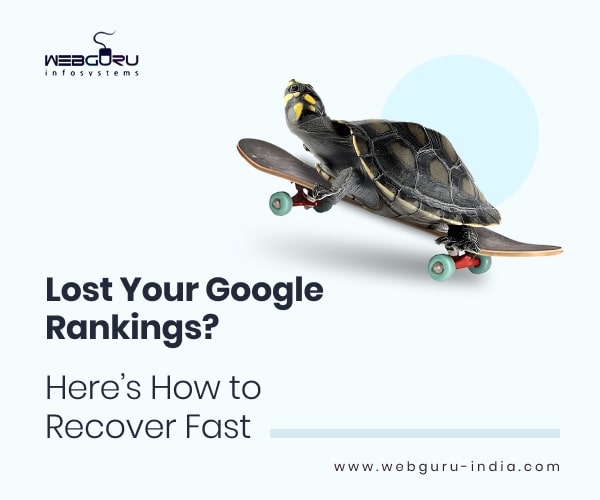Home Blog SEO Services How to Regain Lost Rankings After a Google Algorithm Update
How to Regain Lost Rankings After a Google Algorithm Update
- 24 Mar / 2025
- 866 views
- 9 Min Read

Struggling with a sudden ranking drop after a Google algorithm update? You’re not alone! These are like digital earthquakes, and the aftereffects can be like losing visibility/rankings overnight, leaving you wondering what went wrong. Business owners should follow a step-by-step recovery process—from diagnosing specific issues to implementing proven solutions. Expert SEO service providers say that such algorithm updates are actually opportunities to strengthen your digital presence and deliver more value to the target audience.
Imagine!
Your business website has been steadily rising in the search engine rankings. Traffic is up, conversions are satisfactory, and other factors also seem perfect. Then, nearly overnight, your rankings plummet! It’s heartbreaking to realize that a Google algorithm update has turned your digital world upside down.
This is not at all a mere imagination! Being a leading SEO service provider, we are too familiar with such situations! Google’s algorithms are constantly evolving. In fact, in 2022, it launched 4,725 changes to search, including user interface, ranking systems, and more. It means Google Search is changing 13 times per day (on average)!
Businesses invest months and years to achieve the desired rankings. A single algorithm update can vanish their rankings within hours. A business might face significant lead/revenue losses while the owner figures out what went wrong.
What Are Google Algorithm Updates?
Google makes thousands of changes to its search algorithms each year. Most changes/updates happen in the green room without much fanfare. However, the major updates can dramatically reshape search results across the internet. For example, the March 2024 core update affected many search results across all niches. Google also declared that the update was to reduce low-quality search results.
“You’ll now see 45% less low-quality, unoriginal content in search results versus…”
(Source: Google Search Update, March 2024)
Tips to Recover Rankings Affected by a Google Algorithm Update
After a dramatic ranking drop, panic is the usual response! But that won’t help you recover ranks. Instead, you can try the below-mentioned steps for quicker recovery.
Identify the Impact on Your Website
Following an algorithm update, it’s important to evaluate how your site has been impacted. Keep an eye on your site’s performance metrics, including organic traffic, bounce rate, and conversion rates. A drastic decline in these metrics could mean that your site has been adversely affected. Experts suggest using tools such as Google Analytics or Google Search Console to learn which pages or keywords have seen declines. This data will help you pinpoint areas that need improvement.
Conduct Technical SEO Audit
Most ranking declines result from technical issues that Google’s new algorithms suddenly perceive as more bothersome. You can start by crawling your entire site for broken links, redirect chains, or server mistakes. Check the mobile responsiveness of your site on several devices and display sizes. Page speed has gained importance with each update, so use Google PageSpeed Insights to see where you can improve. Consider adding schema markup if you have not done it yet. The organized data makes search engines understand your content’s purpose and context better.
Do Content Quality Assessment
Quality content is still at the center of the majority of Google updates. Go through your content with fresh eyes or outsource it to a third party for assessment. Search for thin content pages that deliver minimal value to users.
Recent algorithm updates are capable of recognizing low-quality content that is lacking in depth or expertise. Websites with high-quality, expert-written content experience less volatility irrespective of algorithm updates. Check whether your content truly answers user questions comprehensively and authoritatively.
Check Reputation and Authority Signals
Google increasingly considers website authority and trustworthiness in ranking. Scan your backlink profile for spammy links that could cause algorithmic penalties. Assess your brand mentions and citations throughout the web for accuracy and consistency.
Consider your site’s overall E-E-A-T signals (Experience, Expertise, Authoritativeness, and Trustworthiness). Refreshing your About page, author bios, and credentials can sometimes help recovery. Also, don’t miss opportunities to demonstrate industry leadership through guest posting, speaking engagements, or publishing original research.
Perform Competitive Analysis
Ranking drops can occur not because your site got worse, but because competitors got better. Look at sites now ranking where you used to. Study their content strategy, technical setup, and user experience components.
See if they’ve made some specific changes recently that may have tipped the scale in their favor. Pay close attention to how they organize content and answer user intent for relevant search terms. What you learn from competitive analysis usually yields the clearest recovery roadmap.
Build High-Quality Backlinks
Backlinks are still a significant ranking factor. Experts suggest acquiring high-quality, relevant backlinks from authoritative websites. You can try guest blogging, collaborate with popular influencers, and create shareable content to attract natural backlinks.
In the quest of quickly recovering backlinks, don’t fall prey to black-hat SEO. For example, buying links can lead to penalties. A strong backlink profile means Google will accept your site as trustworthy and authoritative which will eventually help recover lost rankings.
Improve User Experience (UX)
User experience plays a crucial role in search rankings. Your website should be easy to navigate, visually appealing, and provide a seamless experience across all devices.
Being a leading SEO company in India, we suggest optimizing page load speeds as you know slow loading can lead to a higher bounce rate. Place clear call-to-actions so that users can easily find the information they need. A positive user experience encourages longer site visits and improves engagement, which can positively impact your position in the SERP.
Create a Recovery Implementation Plan
After a thorough analysis, you should create a prioritized recovery plan based on your findings. Start with quick wins that have the ability to display immediate effect while laying the groundwork for longer-term enhancements.
Record your changes in detail so you can measure what actually works. Track rankings daily throughout the recovery process to determine if there are positive trends. Keep in mind that recovery generally takes time – generally at least until the next big algorithm update. Patience combined with persistent improvement efforts yields the best results.
Google algorithm changes don’t have to mean disaster for your business. They’re opportunities to refine your site and provide more valuable experiences for users.
With methodical analysis and strategic improvements, most websites can regain lost positions and usually come out even stronger. A digital marketing company that keeps pace with algorithm changes earns competitive ground against those that don’t embrace evolution. Embracing the challenge, learning from every update, and continue optimizing your digital presence with user experience as your north star.
Also Read: The Ultimate Year-Round SEO Checklist to Drive Lasting Results
Conclusion
Recovering your rankings from a Google algorithm update requires a multifaceted approach. Understand the nature of the update, assess its impact on your site, and implement strategic movements to regain your lost rankings.
Irrespective of the type of algorithm update, your site should have a motto to deliver information and solve your target audience’s pain points. For that, you should always prioritize content quality, optimize technical aspects, analyze competitor strategies, build high-quality backlinks, and improve user experience.
Stay informed and adaptable to prepare for future changes. Google and you should have the same goal—providing value to your audience.
Being a business owner, your plate is already full, and you have no time to manage all these on your own. The best way out is to hire SEO services. We are nearly a two-decade-old SEO company in India and have been handling many ups and downs caused by algorithm updates. Whether you want to recover your rankings or make your site immune to these updates, we can help you in all possible ways.

Sujata Bhattacharjee
Sujata Bhattacharjee is a versatile content writer with a passion for crafting engaging narratives. Her work blends creativity with expertise, captivating readers across diverse topics effortlessly.

-
1000+
Happy
Clients -
25+
Countries
Served -
19+
Years of
Trust






